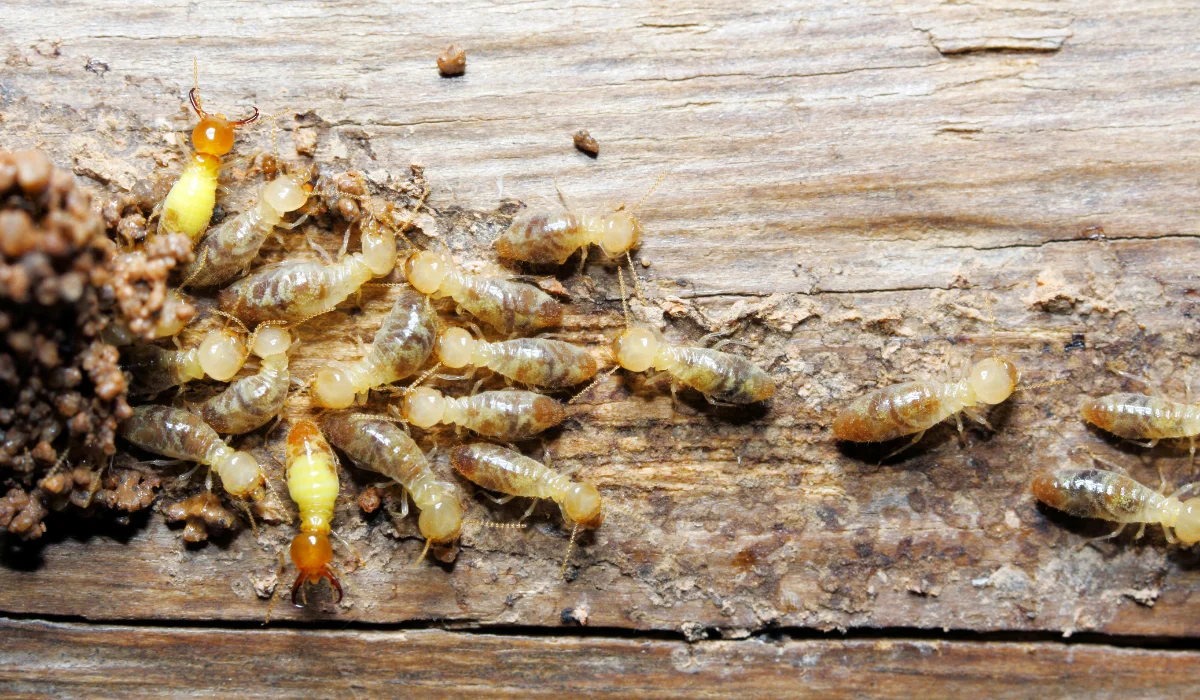
There are few things more unsettling as a homeowner than seeing a winged termite flutter onto your windowsill. By preparing yourself and your home for termite season, you can save yourself (and your neighbors) thousands of dollars in the future.
Understanding how termites spread is crucial for taking preventive measures to ensure your home stays termite-free. Read on to learn how termites spread, and wha you can do to protect your home.
Key Takeaways
- Termites can move between homes through underground tunnels, swarming, infested items, connected wooden structures, and small cracks.
- They spread from house to house for moisture, food, and safer living conditions.
- Common signs of termites may include hollow wood, small piles of frass, mud tubes, discarded wings, and clicking noises.
- Regular checks, fixing leaks, removing wood debris, and seeking help from pest control experts can help keep termites away.
HOW TERMITES TRAVEL BETWEEN HOMES

Many types of termites can invade homes in various ways, causing significant damage. Understanding how they travel between homes can help prevent infestations and protect properties.
Through Subterranean Tunnels
Subterranean termites construct extensive underground mud tube systems to access new food sources. They can travel long distances through these tunnels, from the soil to the wooden structures of the home.
These mud tubes, typically about the width of a pencil, allow them to bridge gaps and enter homes undetected. Once inside, they can spread rapidly, worsening the infestation.
By Swarming
Swarming involves reproductive termites, or alates, leaving their colony to start new ones. Thousands of swarmers emerge during a swarm, typically in the spring or summer. They look for suitable locations to establish new colonies.
Swarming termites lose their wings after mating and begin nesting in wood and soil. If left unchecked, they can establish new colonies, leading to infestations.
By Hitching a Ride on Infested Items
Species like drywood termites can spread to new locations by traveling with infested items. This includes moving infested wood or furniture from place to place. Even small objects like cardboard boxes can harbor termites if they originate from an infested area.
Through Wood-to-Wood Contact
Termites can move between homes that have wooden structures touching each other. For instance, fences, decks, or even stacks of wood directly touching homes provide pathways for termites to spread.
If they infest one structure, they can easily migrate to the next, continuing their search for food sources. Ensuring that wooden parts of buildings do not touch each other can prevent the spread of termite damage.
Via Cracks in Foundations and Walls
Termites exploit cracks and crevices in foundations and walls to enter homes. These entry points provide easy access to a structure’s interior. Subterranean termites, in particular, are adept at using tiny gaps to gain entry and build their nests.
WHY TERMITES MOVE FROM ONE HOUSE TO ANOTHER
Termites often migrate from one house to another for better living conditions. To thrive, they need moisture, food sources like cellulose, and a safe environment.
As they can eat roughly 11 pounds of wood in a month, a mature termite colony may deplete its food supply immediately. So, they look for new sources. This includes the wood and materials in your neighbor’s home or the one next door.
As they continue to seek out ideal conditions, you must stay vigilant for any signs they may have already reached your home.
Signs Termites Have Spread To Your Home
Spotting the signs of termite infestations in your home can be tricky. Here are some telltale signs to look for:
| Sign | How to Spot Them |
|---|---|
| Hollow-sounding wood | Tap on wooden structures; look for thin, paper-like outer layers. |
| Frass | Look for small piles of frass near baseboards or wooden areas. |
| Mud tubes | Check hidden areas like basements and crawl spaces. |
| Discarded wings | Inspect windowsills and doorframes for shed wings. |
| Bubbling or uneven paint | Look for paint that seems off or inconsistent. |
| Clicking noises | Listen carefully in quiet areas, especially at night. |
| Damaged wood | Examine wooden furniture, beams, and floorings closely. |
If you see these signs, a termite inspection may be necessary. A professional termite exterminator can help confirm and tackle the termite problem.
HOW TO PREVENT TERMITES FROM SPREADING TO YOUR HOME
As homeowners, proactive action is a must to prevent an infestation. Without immediate intervention, termite infestations spread as quickly as the queen termite’s reproduction efforts.
For year-round peace of mind, consider these termite prevention strategies:
- Regular Inspections: Inspect basements, crawl spaces, and attics for any signs of termite activity.
- Maintain Proper Ventilation: Use proper ventilation systems to reduce moisture.
- Remove Wood and Debris: Keep firewood, lumber, and paper away from the foundation.
- Fix Water Leaks: Make sure gutters and downspouts direct water away from your home.
- Use Treated Wood: When building or renovating, use termite-resistant or treated wood.
- Apply Products and Barriers: Apply EPA-approved products or install barriers as termite treatment during construction.
- Check Landscaping: Keep bushes and trees trimmed, ensuring they don’t touch the house.
- Hire Pest Control Professionals: Always contact the experts for professional termite control services.
SHOULD YOU CALL PEST CONTROL SERVICES
Spotted some suspicious wood damage? It’s a good idea to call a pest control company today. Since termites can cause extensive harm quickly, immediate action from pest control experts is needed to avoid expensive repairs.
Whether you’re in Baton Rouge or New Orleans, seeking expert help should be easy. For immediate intervention for a severe infestation, let Lajaunie’s termite control specialists tailor a solution that’s right for your home.
For more information about the areas we service, call today at 985-316-5652.